The Via Francigena is translated to mean
"Your Road of the Faith". This was the medieval road of the pilgrims toward Rome
and the Jubilees.
In 1994 the road has received the recognition of the "European
Cultural Itinerary" from the European Council.
The Via Francigena was rediscovered to have run over the same routes as
the Roman roads. In fact they were probably one and the same. After the fall of the Roman
Empire the Via Francigena was reduced to poor condition because of the notable reduction
of the commerce and the trips during the barbaric invasions.
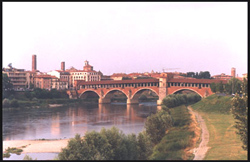 |
The documentary and the DVD will introduce
the natural, artistic, religious and cultural " mirabilias " met by a
tourist-pilgrim that, today, will cross the Francigena Road along the 1800 kilometers that
separate Rome from Canterbury.
|
Particularly meaningful and
fascinating is the possibility that the Via Francigena Road can be used to travel by foot,
bicycle, horse, or by auto. Even to this day this authentic medieval road still has intact
bridges of Roman epoch.
Testimony of the longevity of the Francigena is shown through the fact
that many routes have been asphalted and they are still used by ordinary traffic.
| The documentary and the DVD will introduce this whole period of
the Middle Ages to our days, from the cathedral of Reims to the ruins of the small oratory
of Gesi˛n near Ivrea. There are many large, grand, buildings that are full of intense
charm. |
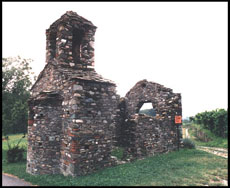 |
The layout of the Via Francigena in its Italian section is sketched with the entrance of the Longobards at the end of the
seventh century.
The Longobard Kingdom was centered in Pavia and needed a connection
with their Dukedoms at the center and southern parts of Italy. They needed a road secure
from raids of the Byzantines or the Roman East Empire.
The Byzantines belonged to the empire of east, in the territories of
the "Esarcato of Ravenna" and the two "Pentapolis". The Byzantines
monitored the passage of oriental travelers of Appennino. These travelers would cross
using Roman roads like The Florence-Faenza. These passages were located in the territories
along the tall Adriatic on which the consulars Roman roads Flaminia and Popilia were not
monitored.
To cross the Appennino tosco-emiliano, the Longobards were therefore
forced to choose the layout of the ancient Roman Road Parma-Lucca as well as the Via
Aemilia Scauri. The road of the Bardone Mountain was called (the Mons Langobardorum, now
Cisa Pass), it was the artery that gave origin to the future Francigena Road.
After the conquest of the Lunigiana, the Byzantine territories grew
outward from the Ligure Sea, the road of the Bardone mountain was equipped and made easier
to travel.
Meanwhile the Road was starting to be crossed by the troops from the
Longobard population. The road was also being used by the arriving pilgrims from the
southwest of Europe and from the British Islands that were traveling toward Rome or
Jerusalem.
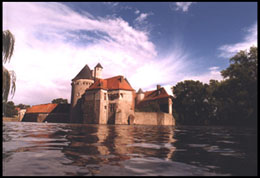 |
To the end of the ninth century with the
hunting party of the Longobards from the Franchis, it begins to appear in the documents of
the epoch the name of Francigena Road or "Francisca" that is originated from
France. This has been determined that this was not an actual nation, but a geographical
denomination that at this time period understood this to be the territories around the
river Rhine and the Netherlands.
|
The Via Francigena assisted in
Europe's general renewing of spirit that adds to a demographic increase, and to a
progressive economic comfort.
The development of the Via Francigena is due to the different positive
exchanges of pilgrimages. The Via Francigena has involved "in primis " of it.
Shortly the Road, therefore, became the more important European road of
the Middle Ages, the principal "high way" between the cities of the northwest of
Europe and the Roman capital. At one point of only the Roman Empire and now of all
Christianity.
The Via Francigena has been crossed by merchants, pilgrims, by kings
and armies. At the end of 1000 AD it was use by knights and Crusaders coming from
"ultra Alps" to regain the Saint Sepulchre.
The trip toward the tomb of the apostles Pietro and Paul united the
rich man to the poor man, the prelate to the wandering pilgrim.
The Via Francigena dealt with an authentic adventure. It was studded
with traps, dangers and natural obstacles, but was regarded also as a walk of
purification, as well as a walk of discovery in the search of a new man.
The Road didn't maintain the aboriginal run, but during the years it
changed more times from different political, physical, atmospheric factors.
Different names were
given to The Via Francigena as it crossed through French territory. Some of the names were
Chemin Romiou, Chemin des Anglais, Route des Flandres.
Between the different chronicles that has been passed on to us of
pilgrimages along the Via Francigena, we have chosen to highlight the one of Sigerico,
Archbishop of Canterbury. The Archbishop departed for Rome in the spring of 990 AD to
receive from the Pope the "pallium ", wool dress adorned by the cross symbol of
the Episcopalian investiture.
|
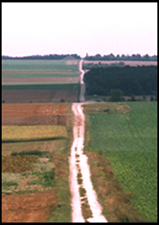 |
The Archbishop Sigerico reached the
Urbe in July and stayed only two days, just long enough to meet with Pope Giovanni XV and
to quickly visit the churches of the eternal city.
The Archbishop Sigerico write of his return journey named the
"submansiones de Rome usque ad mare". The Archbishop told and chronicled eighty
places, from the Urbe to English Channel. Among these places were big cities and small
suburbs, some of which disappeared many centuries ago.
The best know transcripts of the Archbishops journey, which references
are made in his itinerary are: Arras, Reims, Pontarlier, Besanšon, Lausanne, Martigny,
the Big St. Bernard Pass, Aosta, Ivrea, Vercelli, Pavia, Piacenza, Fidenza, the footstep
of the Cisa, Pontremoli, Massa, Lucca, San Gimignano, Siena, Bolsena, Rome.
An average trip on The Via Francigena covered about thirty kilometers a
day. This was done mainly on foot. The more fortunate people would cross by mule. While
the most powerful and prestigious people, such as Kings, would travel this road by horse.
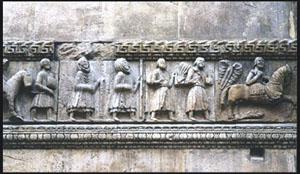 |
Based on these average distances pilgrims had to spend the night
and refreshed themselves at taverns and inns along the way.
"Spedali"
refuges, religious congregations normally managed these tavern and Inns, or by private
institutions, some of which have survived to this day.
|
This normally offered a pilgrim a roof over their head, some straw
to sleep on and sometimes a frugal meal.
During 1200 AD, after centuries of forgetfulness or
lack of local use entirely, travelers started bypassing the Pass of the Central-Eastern
Alps. First between the whole Brennero Pass using other passes of the Appennini, giving
origin to the new current traffic of pilgrims and merchants.
These new passes lead to the decay of the Via Francigena, which in
turn removed it from being a road line that was a important national artery of regional
value.
Buy the
DVD
Go to home page
visit also our
magazine:
http://www.tizianobiasioli.it/
and
http://www.belleepoquefilm.it/
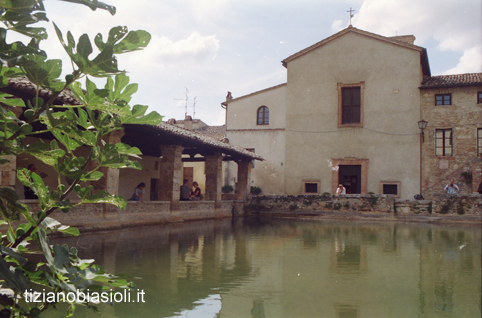
Bagno Vignoni 1999 |